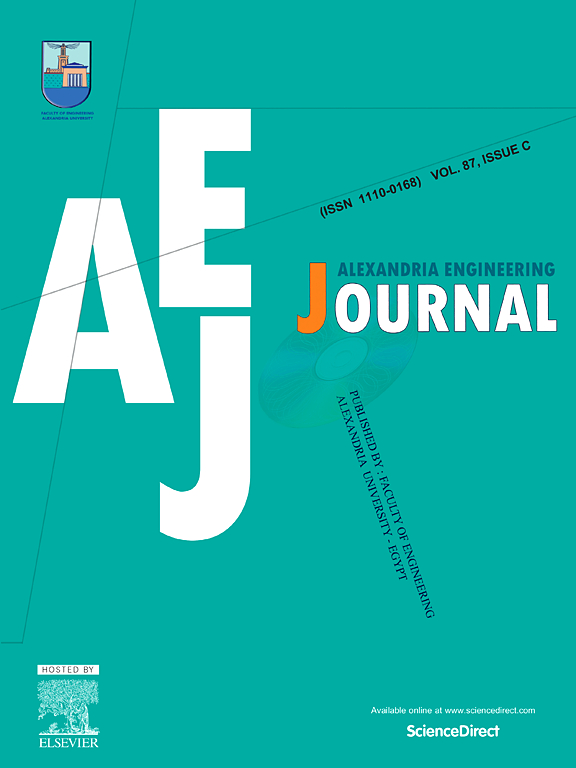二氧化钛/壳聚糖纳米复合涂层的研制与评价
IF 6.8
2区 工程技术
Q1 ENGINEERING, MULTIDISCIPLINARY
引用次数: 0
摘要
研究了TiO2/壳聚糖纳米复合涂层在食品保鲜中的应用,重点研究了其理化性质和保鲜效果。纳米复合材料的平均粒径为85 ± 5 nm, zeta电位范围为+ 35.2 mV ~ + 42.8 mV。FTIR分析显示,钛原子与壳聚糖之间的配位键位于1384 cm-1处,而XRD图证实了TiO2纳米颗粒的成功掺入,没有发生相变。最佳配方(1.0 % TiO2)表现出显著的保存效果,与对照组相比,呼吸活性降低42 %,过氧化物酶活性比未处理的样品低65 %。15天后,处理样品的丙二醛水平保持在1.68 μmol/kg,而对照组的丙二醛水平为4.25 μmol/kg。纳米复合涂层有效地抑制了微生物的生长,在整个储存过程中保持总需氧计数低于3.5 log CFU/g,同时保留了必需营养素,抗坏血酸含量保持了78% %。百里香酚的加入增强了抗菌效果,对大肠杆菌产生18.5 mm的抑制区。该涂层的稳定性保持在30天以上,粒径分布的变化小于5% %,表明其在商业食品保鲜应用中的潜力。本文章由计算机程序翻译,如有差异,请以英文原文为准。
Development and evaluation of titanium dioxide/chitosan nanocomposite coatings for enhanced food preservation and nutrient retention
This study investigated the development and application of TiO2/chitosan nanocomposite coatings for food preservation, focusing on their physicochemical properties and preservation efficacy. The nanocomposite synthesis achieved uniform particle dispersion with an average size of 85 ± 5 nm and zeta potential ranging from + 35.2 mV to + 42.8 mV. FTIR analysis revealed characteristic coordination bonds at 1384 cm-1 between Ti atoms and chitosan amino groups, while XRD patterns confirmed successful incorporation of TiO2 nanoparticles without phase transformation. The optimal formulation (1.0 % TiO2) demonstrated remarkable preservation effects, reducing respiratory activity by 42 % compared to controls and maintaining peroxidase activity 65 % lower than untreated samples. MDA levels in treated samples remained at 1.68 μmol/kg compared to 4.25 μmol/kg in controls after 15 days. The nanocomposite coating effectively suppressed microbial growth, maintaining total aerobic counts below 3.5 log CFU/g throughout storage, while preserving essential nutrients with 78 % retention of ascorbic acid content. The addition of thymol enhanced antimicrobial efficacy, generating inhibition zones of 18.5 mm against E. coli. The coating's stability was maintained over 30 days with less than 5 % variation in particle size distribution, demonstrating its potential for commercial food preservation applications.
求助全文
通过发布文献求助,成功后即可免费获取论文全文。
去求助
来源期刊

alexandria engineering journal
Engineering-General Engineering
CiteScore
11.20
自引率
4.40%
发文量
1015
审稿时长
43 days
期刊介绍:
Alexandria Engineering Journal is an international journal devoted to publishing high quality papers in the field of engineering and applied science. Alexandria Engineering Journal is cited in the Engineering Information Services (EIS) and the Chemical Abstracts (CA). The papers published in Alexandria Engineering Journal are grouped into five sections, according to the following classification:
• Mechanical, Production, Marine and Textile Engineering
• Electrical Engineering, Computer Science and Nuclear Engineering
• Civil and Architecture Engineering
• Chemical Engineering and Applied Sciences
• Environmental Engineering
 求助内容:
求助内容: 应助结果提醒方式:
应助结果提醒方式:


